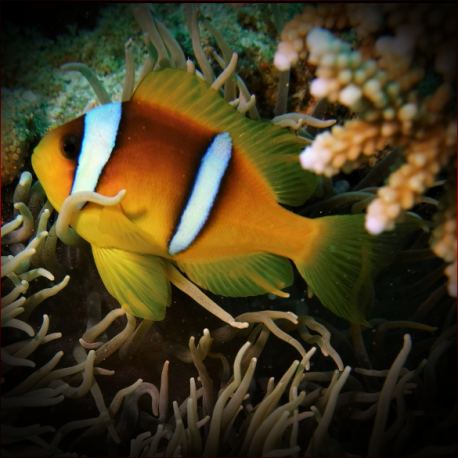More info
Datasheet
| Minimum Tank Size | 200 litres / 52.83 US gallons |
| Maximum Size | 11.0cm / 4.33inches |
| Reef Compatible | Always reef safe |
| Temperament | Might be aggressive towards other species |
| Temperature | 22.2°C / 71.96°F - 25.6°C / 78.08°F |
| Specific Gravity | 1.020-1.025 |
| Carbonate Hardness | 8-12 |
| pH | 8.1-8.4 |
General Description
Amphiprion bicinctus, commonly known as the Two-banded Clownfish, is a member of the Pomacentridae family, specifically the Amphiprion genus. Found in the Western Indian Ocean in regions like the Red Sea and Chagos Archipelago, these fish are characterized by their vivid coloration and territorial behavior.
Aquarium Suitability
Two-banded Clownfish are deemed suitable for most aquariums, but potential owners should be aware of their territorial nature. They thrive in pairs (a male and a female) or two males to one female, while two females together may lead to conflict. Keeping only one pair per tank is recommended due to their aggressive tendencies towards their own kind.
Demands, Care, and Hardiness
Known for their hardiness, Two-banded Clownfish are relatively easy to care for in aquariums. They prefer living in pairs and do well in smaller tanks due to their limited swimming range. When setting up a reef tank, these clownfish are a popular choice, given their adaptability and ability to thrive in such environments.
Reef Suitability
These clownfish are considered reef safe and can coexist peacefully in reef aquariums. While they may display aggression towards other fish, especially when defending their territory or guarding eggs, they generally pose no threat to reef structures or inhabitants.
Aquarium Setup
Setting up an aquarium for Two-banded Clownfish involves providing suitable hiding spots and territories within the tank. Anemones, corals like Hammercoral or Xenia, or similar structures can serve as shelters for these fish. Maintaining appropriate water conditions with a pH of 8.1-8.4, a temperature range of 22.2-25.6°C, and a specific gravity of 1.020-1.025 is crucial for their well-being.
Behaviour
Two-banded Clownfish exhibit fascinating social behaviors, especially when breeding or carrying eggs. They are known to become more territorial when paired with anemones or during breeding periods. Their territorial instincts can lead to aggression towards other fish that encroach upon their space.
Feeding and Diet
In the wild, Two-banded Clownfish primarily feed on microalgae, small crustaceans like krill and artemia, and zooplankton. Providing a varied diet including microalgae and small crustaceans like mysis or artemia is essential for their health and well-being in captivity.
Dimorphism
These clownfish exhibit sexual dimorphism, where the female is typically larger than the male. They can also change gender from male to female, with only one pair recommended per aquarium due to their territorial behavior. In some cases, one female can coexist with multiple males successfully.
Habitat and Distribution
Two-banded Clownfish, belonging to the Amphiprion genus, are native to the Western Indian Ocean, specifically the Red Sea and Chagos Archipelago. They are commonly found in reef environments, often associating with anemones or other coral structures for shelter and protection.

